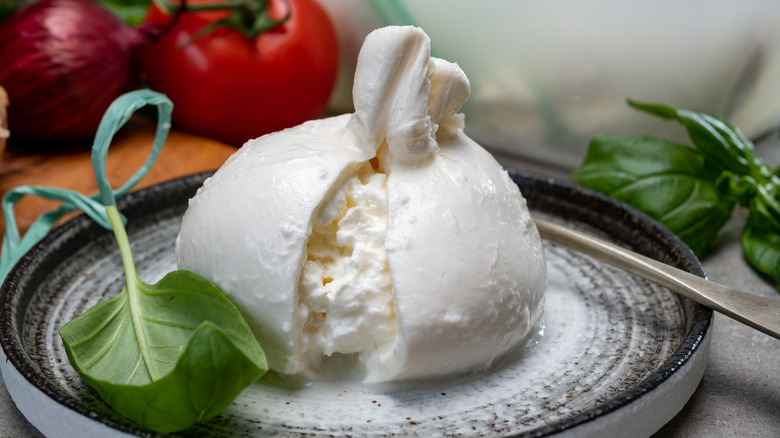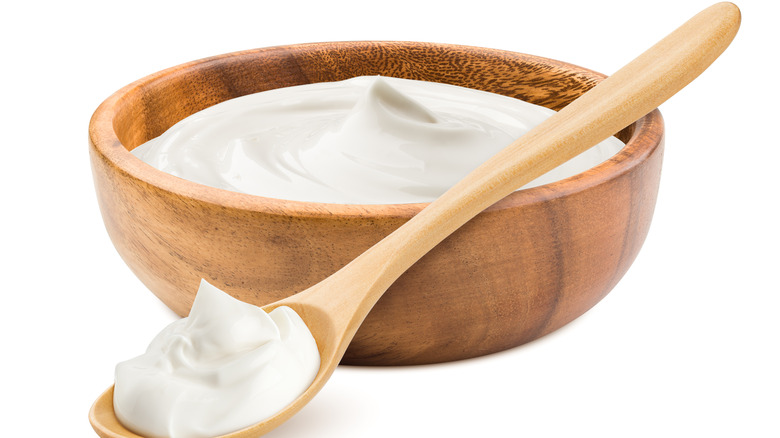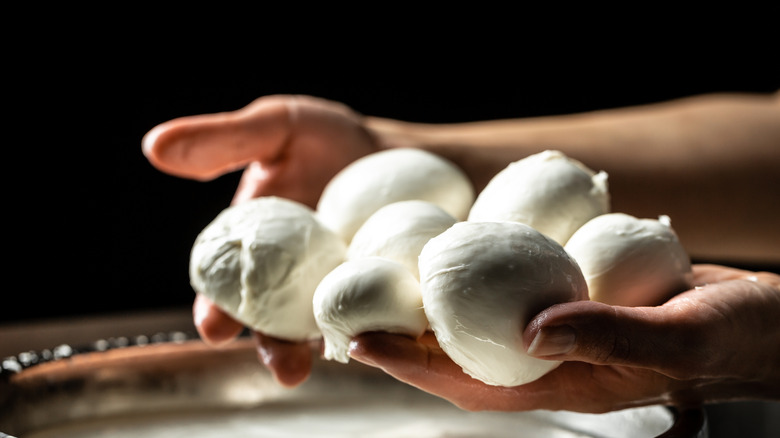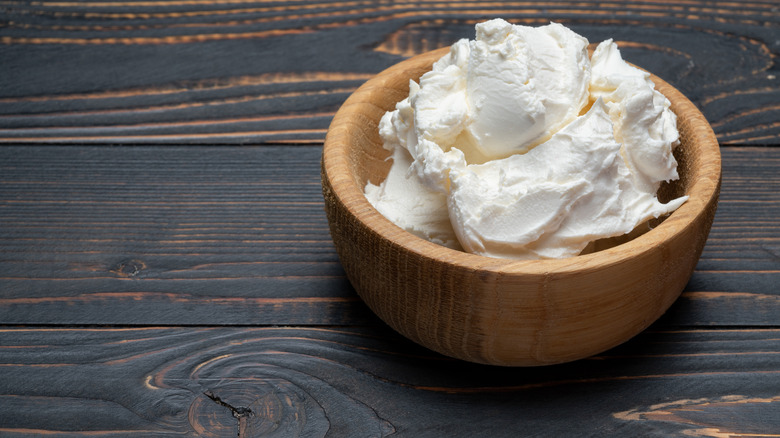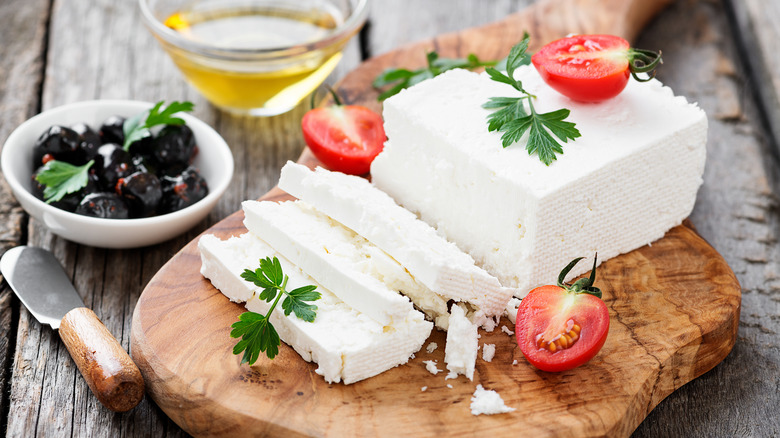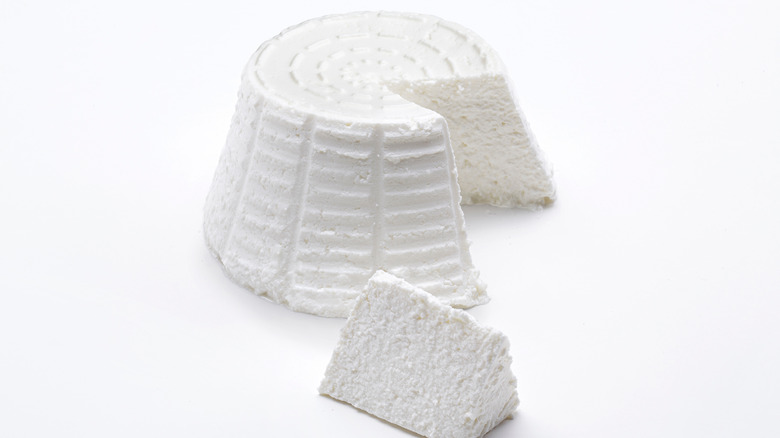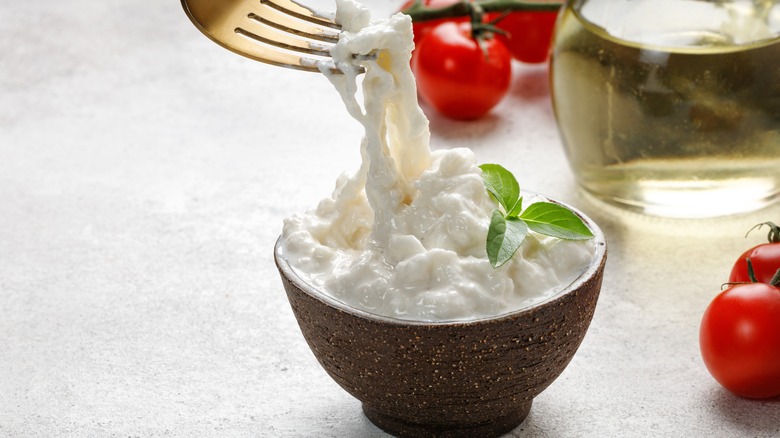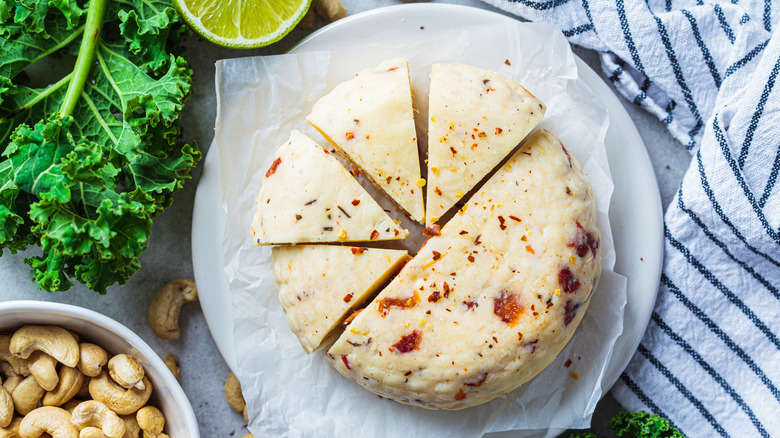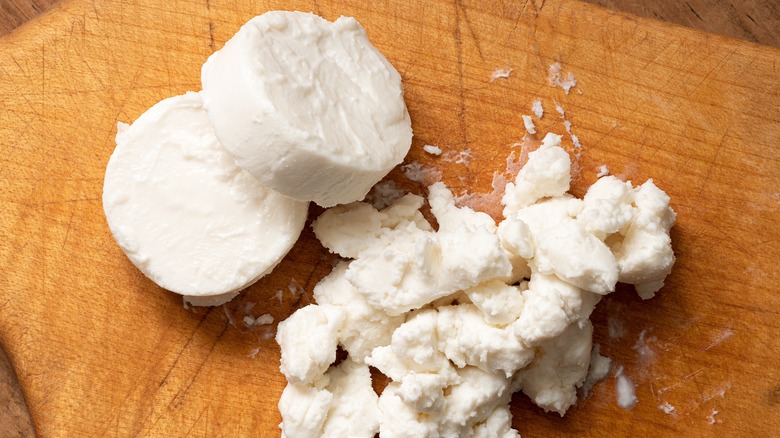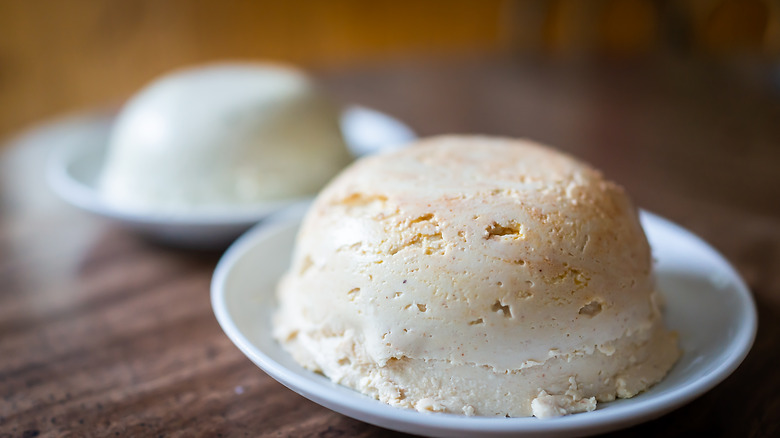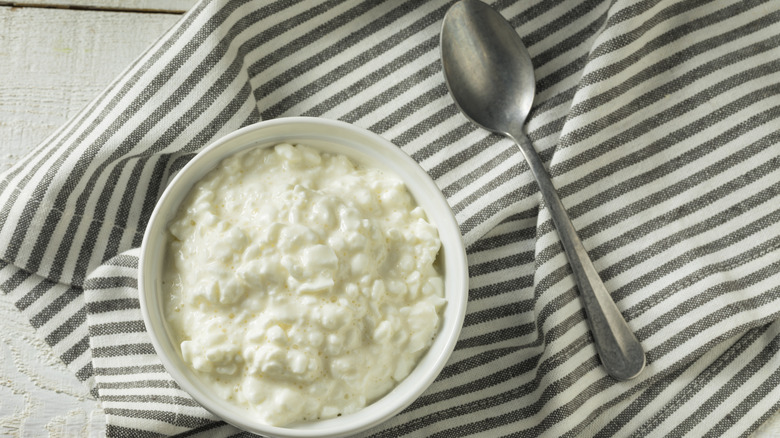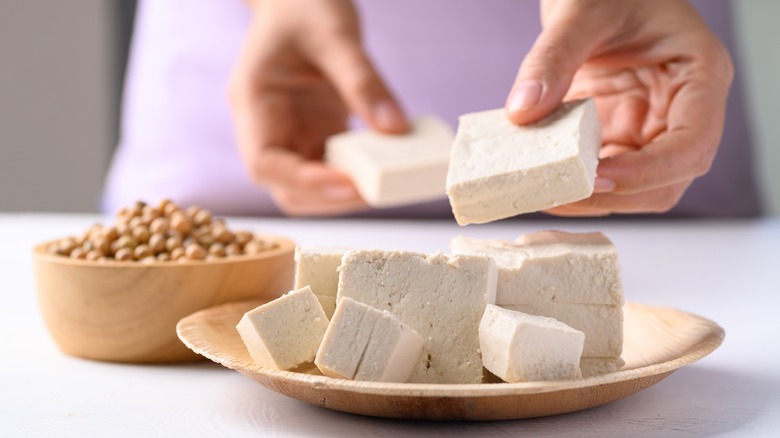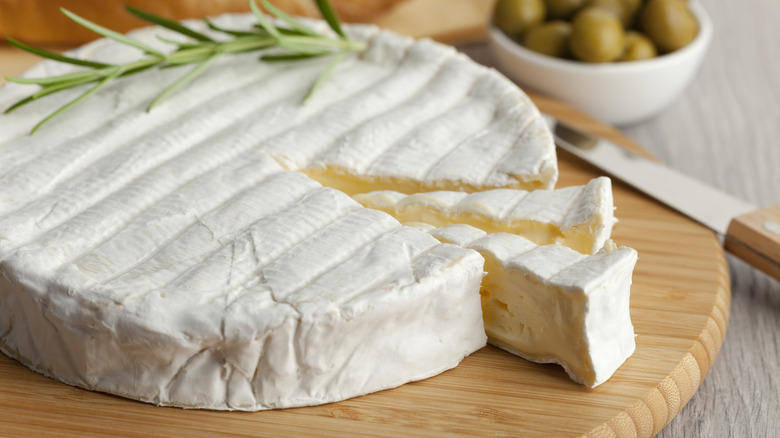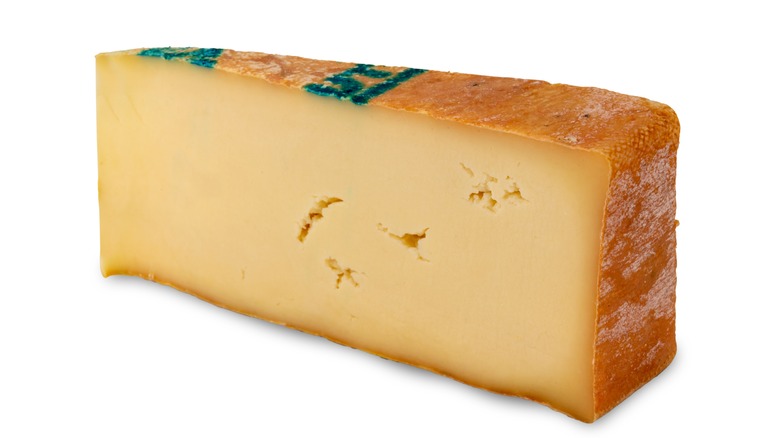14 Absolute Best Substitutes For Burrata Cheese
You may have heard of burrata if you're familiar with Italian cheeses. Burrata is so good and complex that it's best served on its own, with a drizzle of olive oil, sea salt, and a slice of crusty bread. But, on the other hand, it's a versatile cheese that's perfect for topping a salad, pizzas, or even dessert grilled nectarines.
But what is burrata? Well, believe it or not, it's actually two cheese varieties served as one. Burrata is made similarly to mozzarella by heating the milk and separating the curds. Then, part of the curd is warmed until it becomes stretchable (that's the mozzarella shell of the burrata). The other parts of the curd are soaked in cream, and the mixture gets stuffed inside the mozzarella pouch. The cheese obtained through this process resembles a ball that releases a creamy interior when cut. So, there you go — two cheese varieties in one.
It can be challenging to find burrata sometimes, and you might find yourself needing it for a recipe or just craving a mouthful of that creamy, stringy texture. What to do when you're fresh out and can't locate any? Give one of these burrata substitutes a try.
Cream cheese
As the inside of the burrata is creamy and soft, cream cheese can be a good substitute for burrata cheese. Cream cheese is a soft, spreadable cheese that is popular in many cuisines around the world. It has a gentle flavor and a smooth, creamy texture, making it a versatile ingredient in sweet and savory dishes.
The taste of cream cheese can be described as slightly tangy and sweet, with a subtle and velvety richness. Its texture is smooth and can range from soft and spreadable to slightly firmer and sliceable, depending on how it is made.
Burrata has a richer, more complex flavor and a softer texture than cream cheese, so the latter will only replace it partially. However, cream cheese works as a replacement because it has a similar texture and can provide a similar sour taste. When substituting, use a one-to-one ratio. In addition, you can add other ingredients to the cream cheese, such as mozzarella cheese, if you want a texture that more closely resembles burrata.
Mozzarella cheese
Mozzarella cheese is a simplified, similar-looking relative of burrata. Both cheese varieties are round-shaped and come in water-filled containers. The main difference between mozzarella and burrata is the internal consistency. Unlike mozzarella, which has a similar exterior and interior texture, burrata has an outer consistency like mozzarella but is creamy inside. However, despite this difference in texture, mozzarella is an excellent burrata substitute.
It's best to replace burrata with mozzarella in recipes that call for melted or soft cheese, such as pizzas, salads, and sandwiches. To make a substitution, you can use a ball of fresh mozzarella and add a dollop of ricotta cheese in the center to mimic the creaminess of the burrata. Alternatively, you can mix mozzarella and heavy cream to create a similar texture.
While mozzarella may not have the same luxurious creaminess as burrata, it has a soft flavor and smooth texture that can still add richness to dishes. In addition, mozzarella is widely available and more affordable than burrata, making it a convenient alternative for those who cannot find or afford burrata cheese.
Mascarpone
Mascarpone cheese is a creamy, rich Italian cheese that works very well in place of burrata in some recipes. Mascarpone cheese is made from cow's milk and has a smooth, silky texture similar to cream cheese. However, unlike burrata, which has a mozzarella shell and creamy interior, mascarpone cheese is soft and spreadable.
Mascarpone cheese has a sweet, delicate flavor that is slightly sour. Its rich, buttery taste is perfect for use in both sweet and savory dishes. Mascarpone cheese originated in the Lombardy region of Italy and has been used in the Italian cuisine for centuries. The best-known use for mascarpone is tiramisu, the iconic Italian dessert featuring espresso-soaked ladyfingers, mascarpone cream, and cocoa.
When substituting burrata with mascarpone cheese, a ratio of two-to-one is recommended. For example, two ounces of mascarpone cheese can replace one ounce of burrata. Some suitable recipes for a substitution include pasta dishes or salads. In these dishes, mascarpone cheese can be used as a creamy sauce to replace the softness of the burrata.
Feta cheese
Feta cheese is a famous Mediterranean cheese that can replace burrata in some dishes because of its slightly sour taste. Feta cheese is made from sheep or goat milk and has a crumbly texture that's far firmer than burrata and lacks the creamy, luxurious consistency that characterizes it. However, feta can be crumbled easily, adding a delicious salty kick to any dish.
The ratio can vary depending on the recipe when substituting feta cheese for burrata. Generally, a one-to-one substitution is not recommended, as feta cheese has a more robust flavor and a different texture. Instead, it is recommended to use feta cheese in smaller quantities or in combination with other ingredients to achieve a similar taste and texture to burrata. While feta cheese cannot fully replicate burrata's consistency and flavor, it can be a suitable substitute in specific recipes, adding its unique taste to the dish.
Ricotta cheese
Ricotta cheese is a creamy, fresh cheese that comes from Italy. It is made from the whey that is left over after making other types of cheese, such as mozzarella or provolone. Compared to burrata, ricotta cheese has a slightly grainy texture and a mild, somewhat sweet flavor. It also has a lower fat content, making it a healthier alternative. Despite being a byproduct of other cheeses, ricotta cheese has a long history of use in Italian cuisine, with references dating back to the 14th century.
A one-to-one ratio can be used when substituting burrata with ricotta cheese, though the texture and flavor will be different. Ricotta can be used in various dishes, including pizzas, pasta, and salads. It can also be used as a topping for toast or as a filling for desserts like cannoli. A Caprese salad is a popular recipe in which ricotta can serve as a burrata substitute. Instead of using slices of burrata cheese, simply spoon dollops of ricotta cheese onto sliced tomatoes and fresh basil leaves and drizzle with olive oil and balsamic vinegar.
Bocconcini cheese
Bocconcini cheese is a fresh, semi-soft cheese that is a perfect substitute for burrata due to its creamy flavor and soft texture. Bocconcini cheese is made from cow's milk and has a slightly salty and uniquely milky flavor. The cheese is often sold in small, bite-sized balls perfect for snacking or salads.
Although bocconcini cheese and burrata are different types of cheese, they are both made from the same curd. The main difference is that burrata is filled with cream and bocconcini is not. As a result, bocconcini has a firmer texture than burrata but still has a creamy flavor that makes it a great alternative.
When substituting burrata with bocconcini, the ratio should be one-to-one. For example, if a recipe calls for one ball of burrata, you can use one ball of bocconcini instead. However, remember that bocconcini will not have the same creamy center as burrata. Therefore, bocconcini is best used to replace burrata on top of pizzas or sandwiches with prosciutto, tomatoes, and basil, where the creamy texture that characterizes burrata is not essential to the dish.
Stracciatella cheese
Stracciatella is a very trendy Italian cheese with a confusing name, as it also refers to ice cream and a type of soup. It is also the forerunner of burrata, as it's made from the same ingredients (mozzarella and cream cheese) but comes in a less elaborate shape. As such, stracciatella is a great burrata substitute, rendering the same taste. The difference comes from texture, as stracciatella lacks the burrata's perfect, round shape.
When it comes to substitution ratios, it's essential to keep in mind that stracciatella cheese is slightly more liquid than burrata. For this reason, it's recommended to use a one-to-one ratio, but if you find that the stracciatella is too watery, you can use a bit less or strain it before mixing it in your recipe. Many dishes can be made with stracciatella cheese instead of burrata. One popular option is to use it in salads, such as a Caprese salad. Replace the burrata with stracciatella cheese, and you'll have a delicious and creamy salad. Stracciatella can also be used in pasta dishes, such as pasta alla norma or pasta with tomato sauce. It's also a great addition to pizza, especially when paired with fresh tomatoes, basil, and olive oil.
Cashew cheese
Cashew cheese is a vegan and dairy-free alternative to traditional cheese, made from blended raw cashews, water, and various flavorings. Because of its creamy texture and mild taste, cashew cheese works well in place of burrata. Historically, cashew cheese has existed for centuries in countries such as India and Africa, where it is used in traditional cooking. However, in recent years, it has gained popularity in the United States and other Western countries as a dairy-free alternative to cheese.
To make cashew cheese, raw cashews are soaked overnight to soften them before blending with water and seasonings such as nutritional yeast, lemon juice, and salt. The mixture is then strained to create a smooth and creamy texture like cheese. The result is an acidic, nutty, and slightly sweet flavor with a creamy consistency ranging from soft and spreadable to firmer and sliceable.
When it comes to substituting burrata with cashew cheese, the ratio is generally one-to-one. However, cashew cheese can be used in any recipe that calls for burrata. Its creamy texture and slightly sour taste make cashew cheese an excellent substitute for traditional cheese, and it is a perfect choice for those looking for a dairy-free and vegan option.
Queso fresco
Queso fresco is a unique Mexican cheese resembling feta's texture and flavor. It's sourish and crumbly and most often served fresh — not heated. It's also a good burrata alternative in those dishes that rely on flavor. Queso fresco has a lighter flavor and a firmer texture than burrata. It is less creamy and rich but can still add a nice acidic taste to dishes. It is also a lower-fat cheese, making it a healthier alternative.
Queso fresco has a long history in Mexican cuisine, dating back to the pre-Columbian era. It is traditionally made by coagulating milk with rennet or vinegar, then draining the resulting curds and forming them into a mold. Queso fresco is commonly used in enchiladas, tacos, and salads.
When substituting burrata with queso fresco, the ratio will depend on the recipe and personal preference. Generally, queso fresco can be used in a one-to-one ratio with burrata. However, keep in mind that queso fresco will provide a different creaminess than burrata. Suitable recipes for substituting burrata with queso fresco include dishes that call for fresh burrata, but it can be added to some dishes that require cheese cooking.
Almond cheese
Another vegan cheese variety that makes a good substitute for burrata cheese is almond cheese. It is a vegan-friendly alternative to traditional dairy-based cheese made, of course, from almonds. It has a creamy and nutty flavor, with a texture similar to soft cheese, making it a delicious and healthy option for people who are lactose intolerant or following a plant-based diet.
To make almond cheese, soak raw almonds overnight, then blend them with water, lemon juice, and salt until smooth. Then, strain the mixture through cheesecloth and allow it to rest in the fridge until it reaches a desired consistency.
Regarding substitution, almond cheese can be used instead of burrata in many recipes. The substitution ratio can be one-to-one, meaning that for every ounce of burrata required in a recipe, one ounce of almond cheese can be used instead. When using almond cheese, it's important to note that the flavor profile may differ slightly from burrata. Almond cheese tastes nutty, while burrata has a creamy, milky flavor. However, the texture of almond cheese is very similar to burrata, making it an excellent alternative for recipes where consistency is essential.
Cottage cheese
Cottage cheese is a versatile and healthy dairy product that can replace burrata cheese in many recipes. Unlike burrata, cottage cheese is a fresh variety made from curdled milk without cream. Cottage cheese has a milky, slightly tangy taste that pairs well with various ingredients. Its texture is lumpy and creamy, with small curds that give it a unique mouthfeel.
Cottage cheese has a nutrient-filled profile and is an excellent source of protein. As such, it's incredibly filling, with a satiating affect` almost similar to eggs. It is also low in fat and calories, making it a healthier alternative to burrata. Cottage cheese is also a good source of calcium, vitamin B12, and other vital nutrients. When substituting cottage cheese for burrata, a one-to-one ratio may not work as they have different textures and flavor profiles. For example, you could use small dollops of cottage cheese in a salad that calls for torn burrata. In a pasta dish that calls for melted burrata, you could try blending cottage cheese with cream and Parmesan cheese to create a creamy sauce.
Tofu
Tofu is a plant-based protein made from soybeans, and it can be used as a substitute for burrata in many dishes. While it may not have the same flavor or texture as burrata, it can be a delicious and healthy alternative. Tofu has a mild flavor and can be seasoned and cooked in various ways so that it tastes differently. Its texture can range from soft and creamy to firm and chewy, depending on the type and how it is prepared. Compared to burrata, tofu is less rich and less fatty, making it a healthier option for those watching their calorie intake.
Tofu has a long history in Asian cuisine, dating back to ancient China. It was introduced to Japan in the 10th century, where it became a staple food. Then, it was brought to the United States in the early 20th century and gained popularity as a vegetarian and vegan protein source. The ratio can vary depending on the dish and personal preference when substituting tofu for burrata. In general, a one-to-one ratio can be used, but it may be necessary to adjust the amount of seasoning or other ingredients to achieve the desired flavor and texture.
Brie cheese
Brie cheese is an excellent choice for substituting burrata because it is also soft and creamy. It has a similar texture and can be used in dishes that rely on burrata's signature creaminess. However, it is essential to note that Brie does not have the same rich, buttery flavor as burrata. Nonetheless, its light taste allows it to blend well alongside other flavors in a dish without overpowering them.
Brie cheese is a soft, creamy cheese that originated in France and is now popular worldwide. It is made from cow's milk, and its texture is smooth and velvety with a white bloomy rind. The flavor of Brie is rich, buttery, and slightly nutty, with a subtle earthy undertone. It has a tender taste that is not overwhelming, making it a versatile cheese that can be used in various dishes.
The substitution ratio of Brie cheese for burrata can vary depending on the recipe and personal preference. Generally, a one-to-one substitution ratio is a good place to start, but some people may prefer more or less Brie depending on their taste. Also, remember that Brie does not have the same rich, buttery flavor as burrata, so adjustments may need to be made to the recipe.
Fontina
Fontina can provide a similar mouthfeel and richness to dishes that call for burrata because of its creamy, rich texture. Fontina cheese is a semi-soft cow's milk cheese originating from Italy's Aosta Valley. It is made from unpasteurized milk and aged for at least three months, resulting in a nutty and earthy flavor profile with a slightly fruity finish. Since Fontina's is smooth and creamy, it's a popular choice for melting.
In terms of flavor, Fontina is milder and nuttier than burrata, but it is an excellent option for heated dishes that call for burrata, as it melts quickly. When using Fontina as a burrata substitute, it's important to note that it won't have the same creaminess, but it can still add a deliciously cheesy flavor to your dish. When substituting burrata with Fontina, the ratio may vary depending on the dish — a good starting point is to use about half the amount of Fontina as you would burrata and adjust as necessary based on your taste and the dish you are making. The best thing about using Fontina to substitute burrata is the decadently cheesy flavor it will bring to your dish.
